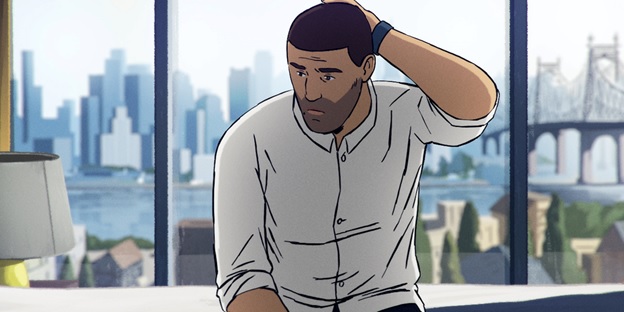Biopics tend to get a bad rep, mostly due to a swathe of listless interrogations of real-life figures, but it’s instructive to remember that a biopic is not really a genre of film. There are many approaches that can be taken to tell the stories of real-life figures as can be seen in two animated films screened at the recently concluded TIFF2021.
There’s a specific moment in the end-credits for the animated film “Charlotte” where my misgivings about its approach to its subject felt confirmed. It’s a holocaust drama that explores the life and works of German-Jewish artist Charlotte Salomon. Salomon is best remembered for a series of autobiographical paintings, 769 individual pieces, combined in a collection called “Life? Or Theater: A Song Play,” written during the Second World War and hailed as the first graphic novel.

Yes, an artist works to prevail during an oppressive war. Who wouldn’t like to consider that story? And everything about “Charlotte” announces itself as a VERY IMPORTANT STORY aware of its VERY IMPORTANT TOPIC. The title of Salomon’s collection conjures feelings of excitement, caprice, unpredictability but little in the film seems true to her collection or Salomon herself. At the end of the film, when the credits roll, we see interviews from some of the real-life people and crucially, we see some images of Charlotte’s work. The works were quickly done with a prescient awareness that life during war time was not assured. The drawings are inventive, odd, unusual, arresting. Her artistic singularity is emphatic. What a shame that this animated film is able to harness none of this artistic panache or singularity. At every turn, “Charlotte” feels maddeningly inert, unambitious and ill-conceived. The issues are myriad.
The all-star cast holds promise–Keira Knightley, Brenda Blethyn, Helen McCrory, Jim Broadbent, Mark Strong, Sophie Okonedo, and the list goes on. It’s easy to see why this story might have seduced such performers, including Marion Cotillard and Xavier Dolan as producers. But this feels like a classic case of an animated film that does not understand the contours of animation. Knightley is a typically dependable actress, and one might imagine a live-action version of “Charlotte” where she could put her talents – a piercing gaze, a steely control of her body – to good use. But without her body to illuminate her work, her voice feels lost.
Okonedo offers the closest thing to a distinctive voice performance, but it’s hard to lay the blame for this at the feet of the actors, who feel directed to recite their lines in tones of diffident properness, spouting off incredibly trite dialogue. It’s astonishingly unsinpired stuff, but it might have worked had directors Eric Warin and Tahir Rana had a more precise vision for the story. This could be a celebration of art in a film form that feels closest to visual art. But “Charlotte” rarely feels artistic. Instead, it feels laboured.
The powers of animation as a form are legion – the possibilities could be endless, but “Charlotte” lacks the texture and specificity of the woman it seeks to extol. It feels disappointing, and like a live-action film that became an animated film by mere happenstance. There’s no real engagement with animation as a form, no risks and very little here of cinematic value. All the moments of pathos could be derived from reading a biography of Charlotte’s life, including her role in a bizarre murder arc that was revealed years after her death, feels too tidy and flattened here. And that’s what makes “Charlotte” feel like such a loss. It feels like a betrayal of the artistic intentions that Charlotte lived for. So much possibility, but little to hold on to.
In contrast, “Flee” offers something more textured, and inventive. The animated documentary, from filmmaker Jonas Poher Rasmussen, tells the story of Amin (a pseudonym) an Afghani refugee, recounting his life on the run to a listening journalist. “Flee” is immediately arresting and affecting. There is an urgency to the word ‘flee’ that immediately prepares audience for something that requires attention. Whether fleeing from or fleeing to, the resolve of the compulsion to flee is precise. When the film opens, Amin is about to marry his fiancé. But before the marriage, he sits down with an interviewer to offer, for the first time, a window into the life he has constructed to keep his refugee identity safe. It is, as if, the imminent change in his life propels an instinctive look back to consider the past; a rare chance to return that from which he once fled.

There’s been a lot of talk about media engaging with trauma over the past few months. Some of this seems to be the inevitable result from the non-filmic conversations about trauma that have marked society’s recognition of the psychological effects of the pandemic. But even amidst a possibly overzealous attribution of trauma as a central theme in media over the last year, “Flee” seems immediately discernible and critical as a film that narratively, textually and aesthetically considers the effects of trauma. The animated-documentary style informs the film’s own resistance to Amin’s identity – it is not his real name, after all. And there’s an inherent reticence in his story even as it ostensibly flows out from him, unencumbered.
Like “Charlotte”, “Flee” is concerned with VERY IMPORTANT ISSUES. Unlike, “Charlotte”, “Flee” is a distinctive film with clear ideas of using the form to explore its issues. Then there are the ways that the story seems to reshape itself at critical moments. It reflexes on itself sometimes, changing from what we heard or saw moments before, and rather than seeming like some tricky engagement with the fluidity of liminal spaces, Rasmussen immediately signals the haziness of memory but also the unwillingness of a traumatised mind to really engage with all parts of the truth. It’s a fascinating aesthetic tool that finds Rasmussen depending on gaps and ellipses to inform the very form of the film.
“Flee” is incredibly easy to watch despite this, though. Even as the film seems to be deconstructing before our eyes, it is also incredibly loose in its formation as it elicits a freedom that feels like a manifestation of Amin’s own sensibilities. Rather than being abstruse, though, there’s an open earnestness to the unfurling that immediately registers as that urgency of ‘fleeing’. And so even amidst the deliberately stylised animation, the nature of the story progression in “Flee” is one which seems to recognise mood and feeling beyond narrative and information. That might seem odd for a documentary, but it’s a sharply incisive tool at who Amin is and what Rasmussen wants us to take away from this story.
“Flee” excellently finds union between Amin’s identity as a refugee, his gay identity and the ways that the story flirts with being read as a kind of postcolonial engagement with issues of statehood and country. As the ‘truth’ of the story mutates from scene to scene, the confessional nature of “Flee” becomes a kind of cyclical coming out. In each moment, Amin confronts the past by coming out as a different version of himself. The specific truths of each coming out are less valuable than the very confession he gives – as if in telling this story he is able to come to some constructed sense of self. Finally.
Postcolonial scholar Stuart Hall writes about the ways that cultural identity is about not just being but about becoming and “Flee” is very much about the nature of a story taking its shape. It spills out from its perspectives in ways that feel spontaneous, but nothing here feels false or accidental. This is decisive filmmaking with a sharp understanding of clarity. How does one even begin to put into words the parts of yourself that you have hidden? How do you reveal yourself to yourself? “Flee” is in constant negotiation with itself and its selves and about what it is and the ways to going about being that. That restlessness is its boon. There are so many layers beneath the melancholy here, each revealing a new perspective on being a person.







